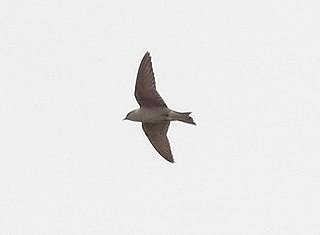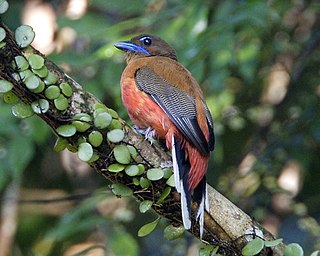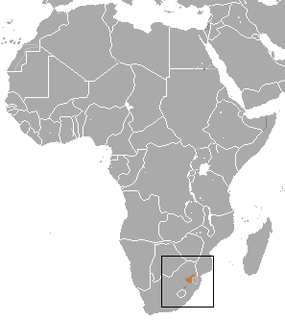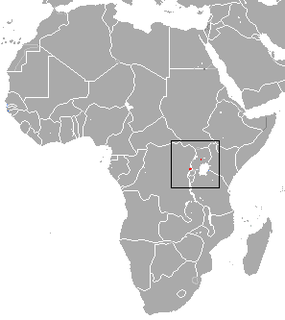Eisentraut's serotine, formerly known as Eisentraut's pipistrelle, is a species of vesper bat in the family Vespertilionidae. It is found in Cameroon, Democratic Republic of the Congo, Kenya, Somalia, and Uganda. Its natural habitats are subtropical or tropical dry forest, subtropical or tropical moist lowland forest, subtropical or tropical mangrove forest, and subtropical or tropical moist montane forest.
The yellow serotine is a species of vesper bat.
The white-winged serotine is a species of vesper bat.
Pseudogynoxys engleri is a species of flowering plant in the family Asteraceae. It is found only in Ecuador. Its natural habitats are subtropical or tropical dry forests, subtropical or tropical moist lowland forests, and subtropical or tropical moist montane forests. It is threatened by habitat loss.
Aiphanes grandis is a species of flowering plant in the family Arecaceae. It is found only in Ecuador. Its natural habitats are subtropical or tropical moist lowland forests and subtropical or tropical moist montane forests. It is threatened by habitat loss.
Ptychadena neumanni is a species of frog in the family Ptychadenidae. It is endemic to Ethiopia.

Fischer's turaco is a species of bird in the family Musophagidae. It is found in Kenya, Somalia, and Tanzania. Its natural habitats are subtropical or tropical moist lowland forest, subtropical or tropical moist montane forest, and arable land. It is threatened by habitat loss.

The Samoan flycatcher is a species of bird in the family Monarchidae. It is endemic to Samoa. Its natural habitats are subtropical or tropical moist lowland forests, subtropical or tropical moist montane forests, and rural gardens and is threatened by habitat loss.

The Peruvian martin is a species of bird in the family Hirundinidae. It is found in Peru and far norther Chile.
Bedford's paradise flycatcher is a species of bird in the family Monarchidae. It is endemic to the Democratic Republic of the Congo.

The scarlet-rumped trogon is a species of bird in the family Trogonidae. It is found in Brunei, Indonesia, Malaysia, Myanmar, and Thailand. Its natural habitats are subtropical or tropical moist lowland forest, subtropical or tropical swamps, and subtropical or tropical moist montane forest. It is threatened by habitat loss.

The highveld golden mole is a species of mammal in the golden mole family, Chrysochloridae. It is found in South Africa and Eswatini. Its natural habitats are temperate forests, subtropical or tropical dry forest, subtropical or tropical moist lowland forest, subtropical or tropical moist montane forest, moist savanna, temperate shrubland, temperate grassland, subtropical or tropical dry lowland grassland, arable land, pastureland, plantations, rural gardens, urban areas, and introduced vegetation. It is threatened by habitat loss.

The tarella shrew is a species of mammal in the family Soricidae. It is found in Democratic Republic of the Congo and Uganda. Its natural habitats are subtropical or tropical moist lowland forest and subtropical or tropical moist montane forest. It is threatened by habitat loss.

The greater large-headed shrew is a species of mammal in the family Soricidae. It is found in Burundi, Democratic Republic of the Congo, Rwanda, and Uganda. Its natural habitats are subtropical or tropical moist lowland forest, subtropical or tropical moist montane forest, and swamps. It is threatened by habitat loss.

Veldkamp's dwarf epauletted fruit bat is a species of bat in the family Pteropodidae. It is monotypic within the genus Nanonycteris. It is found in Benin, Cameroon, Central African Republic, Ivory Coast, Ghana, Guinea, Liberia, Nigeria, Sierra Leone, and Togo. Its natural habitats are subtropical or tropical moist lowland forest, subtropical or tropical mangrove forest, subtropical or tropical moist montane forest, dry savanna, and moist savanna. It is threatened by habitat loss.
Burmeistera domingensis is a species of plant in the family Campanulaceae. It is endemic to Ecuador. Its natural habitats are subtropical or tropical dry forests, subtropical or tropical moist lowland forests, and subtropical or tropical moist montane forests. It is threatened by habitat loss.
Hymenophyllum alveolatum is a species of fern in the family Hymenophyllaceae. It is endemic to Ecuador. Its natural habitats are subtropical or tropical moist lowland forests and subtropical or tropical moist montane forests. It is threatened by habitat loss.
Pecluma pastazensis is a species of fern in the family Polypodiaceae. It is endemic to Ecuador. Its natural habitats are subtropical or tropical moist lowland forests and subtropical or tropical moist montane forests. It is threatened by habitat loss.
Amauropelta campii, synonym Thelypteris campii, is a species of fern in the family Thelypteridaceae. It is endemic to Ecuador. Its natural habitats are subtropical or tropical moist lowland forests and subtropical or tropical moist montane forests. It is threatened by habitat loss.
Tillandsia umbellata is a species of plant in the family Bromeliaceae. It is endemic to Ecuador. Its natural habitats are subtropical or tropical moist lowland forests and subtropical or tropical moist montane forests. It is threatened by habitat loss.








